CNC machining as a manufacturing process encompasses the use of many tools. These tools are unique, yet they are diverse. This means that each one is applicable in different capabilities. Of the many tools used in CNC machining, two tools people confuse for each other are the jig and fixture.
In order to demystify the confusion in jig vs fixture, this article will introduce the tools in terms of their types, differences, and uses. In the end, you will be able to answer the question of what are jigs and fixtures used for? Ready to immerse yourself in knowledge? Let’s get right on it!
What is a Jig?
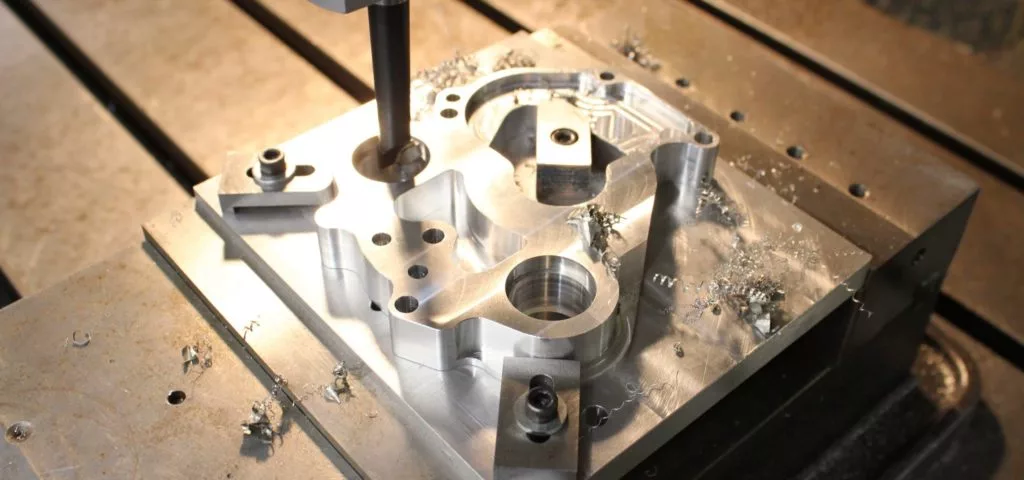
A jig is a device used in securing a workpiece and machine part on a workstation. It is secured to the CNC machine tools such as a lathe cutting tool, where it dictates the location and motion. That means, in a way, it guides such machining tools. Jigs are unique such that when they move, the tool becomes stationary.
Types of Jigs
Jigs are common devices in CNC machining, and they come in different and various types. Below are the common types of jigs used in machining operations.
- Template Jigs: These jigs are simple and ideal due to their accuracy. They also have tremendous speed. However, machinists use them more for accuracy than speed. Template jigs are used in many ways. For example, you can fit them over, or into the workpiece. However, they are not usually clamped.
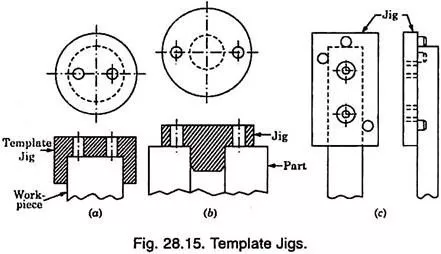
- Angle-Plate Jigs: Angle plate jigs are ideal for holding parts prepared for drilling at angles to their mounting locators.
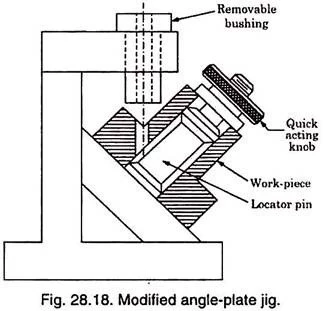
- Plate Jigs: Plate jigs are like template jigs with the same ways of use. However, unlike template jigs, they have built-in clamps to hold the workpiece.
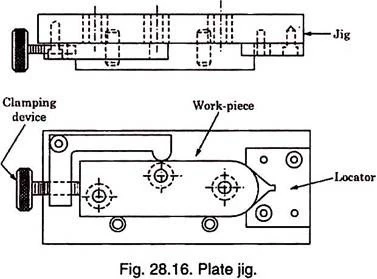
- Leaf Jigs: They have a hinged leaf which makes it easy to load and unload parts. The hinged leaf does not surround the part completely.
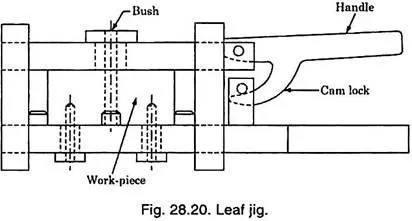
What Is A Fixture?
A fixture or CNC fixture is another popular CNC machining tool regarded as an agent of stability, support, and positioning. Like the jig, it works to secure, support, or mount a workpiece on a CNC machine.
Types of Fixtures
Most machinists are not familiar with fixture classification. No wonder they have a problem with selecting the right one for their operation. The fixtures illustrated below are based on three things: machining operations, uses and power sources. The list will be summarized. For the full version, you can check our article on CNC fixtures.
Fixture Tools Based on the CNC Machining Operation
- Turning Fixtures.
- Milling Fixtures.
- Drilling Fixtures.
- Boring Fixtures.
- Grinding Fixtures.
There are other types of fixtures based on the type of machining operation. We have concluded that every CNC machining operation that needs a fixture takes the operation’s name. Therefore, for operations like honing and lapping, you have CNC honing fixtures and CNC lapping fixtures, respectively.
Fixture Tools Based on their Uses
- Universal Fixtures.
- Special Fixtures.
- Assembled Fixtures.
- Modular Fixtures.
- Combination Fixtures.
Fixture Tools Based on their Power Source
- Manual fixture.
- Pneumatic fixture.
- Hydraulic fixture.
- Electric fixture.
- Magnetic fixture.
- Vacuum fixture.
You can also view this video tutorial for jigs and fixtures:
Differences Between A Jig and Fixture
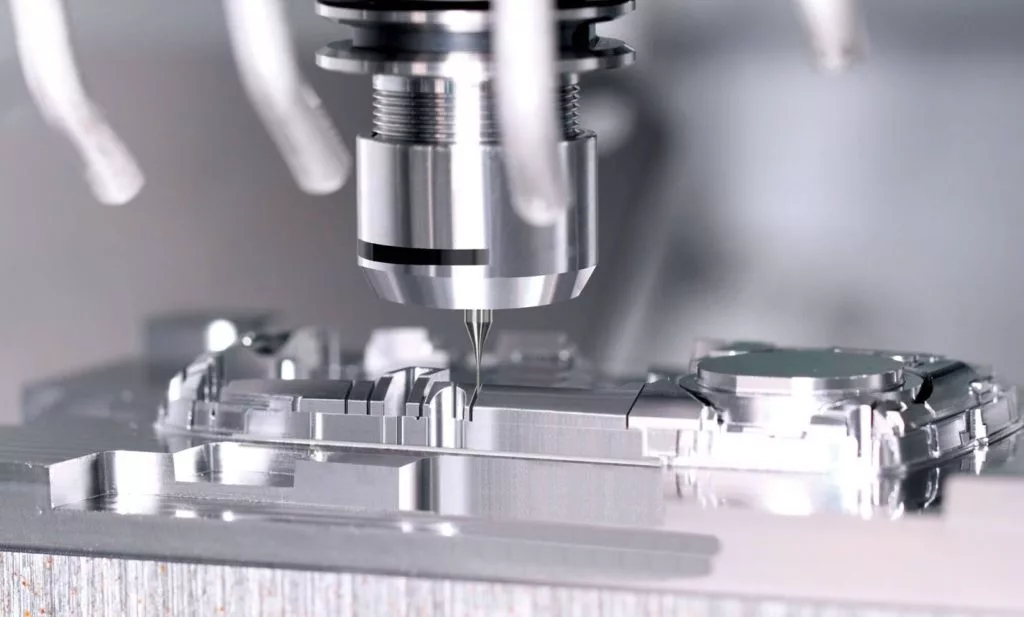
For people new to securing the workpiece on CNC machining or new to CNC machining generally, the jig and fixture can be two very confusing tools. Both tools are similar, and they promote productivity and efficiency. However, they function differently. Below are some highlighted differences between jig and fixtures.
Main Function
The major jig and fixture differences are in their main functions. A jig guides the cutter to work at a predefined location on a workpiece. It also supports and locates the part. The fixture, however, only secures, supports and locates the workpiece. It does not guide the machine part.
Complexity
When comparing a jig and fixture, the machinist agrees that jigs are easier to use. Fixtures require machinists to have some skills before performing an operation.
Weight
Another property to look at is the weight in which jigs are lighter than fixtures. Fixtures are heavier because they have to withstand the huge cutting force and vibration.
Whether Fitted to The Machine
Jigs can be held or fixed on the table depending on the type of work they are used for. Also, jigs do not require additional devices when used in heavy works, although they might need to be clamped. Fixtures, however, require clamping and accessories for better functioning.
Design
Jigs are more complex than fixtures in terms of their construction.
Whether they come in contact with the tool
Fixtures don’t need to come in contact with a machine part since their design is to fit the part. However, a jig must come in contact with the tool to set the angle and position accurately.
Why is Jig and Fixture Important for Machining?
Both the jig and fixture are very important in CNC machining since their advantages make them have wide applications. The following will introduce the applications and advantages of the jig and fixture manufacturing operations.
Application of the Jig and Fixture
The jig and fixture generally function in securing the workpiece and machine parts. However, there is a difference between both. Fixtures are suitable for turning, milling, grinding, sloting and other multidimensional operations. . On the other hand, jigs are suitable for counterboring, tapping, drilling, reaming and other one-dimensional operations.
Advantages of Using Jigs and Fixtures
There are many advantages of using the jig and fixture in any machining operation. Below are a few important ones:
- Better Productivity and Efficiency. Because the two tools eliminate a workpiece’s alignment, a machine’s idle time is reduced, which improves productivity and efficiency.
- Decreases Manufacturing Cost. Their use decreases the product manufacturing cost while increasing productivity and quality. We have article discussing the CNC machining cost, and you can see it.
- Improvement in Quality of Product. They remove the need for machinists to manually set parts apart during operation. Therefore, this removes the human chance of creating errors and improves quality.
- Easy to Manufacture Complex and Heavy Tools. They enable machinists to manufacture heavy and complex-shaped parts easily. This is because the two tools hold the workpiece rigidly during the machining operation.
- Improves Safety. Since the jig and fixture are directly involved in the workpiece and machine, they remove the involvement of humans, thereby increasing safety.
If you want to start your CNC machining project, the leading CNC machining service provider – RapidDirect is your best partner. We focus on creating precision parts at competitive pricing. We also can help you manufacture jigs and fixtures.
How to Make Jigs and Fixtures
CNC machining and 3D printing are the two major ways of making a jig and fixture. However, both processes depend heavily on complexity, volume to be produced, and difficulty making them. Below are what you need to know about making a jig and fixture.
Design
Before designing a jig and fixture, there are some things you must know. Below is a highlight of the common things you must know.
- Study the component.
- Study locating elements.
- Know the type and capacity of the machine.
- Know the loading and unloading arrangement.
- Get to know the clamping arrangement.
- Study the power devices and safety arrangement devices.
- Know the clearance between the jig or fixtures and their components.
- Study of ejecting devices, table fixing arrangement, and the indexing device.
Materials Used in Making the Jig and Fixture
Selecting a material to be used for making a jig or fixture depends on its application and machining operation requirements. Below are the materials used in making a jig and fixture.
- Steel (Stainless, Hard, Carbide, Mild, High Speed).
- Cast iron.
- Hardened Aluminum.
- Plastic: Derlin, Nylon, and PC.
- Bronze.
Manufacturing
Jigs and fixtures are manufactured in two ways: CNC machining and 3D printing. Each method is unique and depends on the type of materials and the machining operations requirement. Below is an explanation of the two ways.
3D Printing
Of the two ways, 3D printing is more used has many advantages over CNC machining. It is cheaper, faster and also provides manufacturers with the flexibility required to re-optimize design.
3D printing jigs and fixtures also allow for better design complexity without an increase in cost. Manufacturers can also add other functionalities to improve the performance of the jig and fixture. Below are the steps to take to make a jig and fixture using 3D printing.
- Verify the dimensional accuracy of the jigs and fixture. You can do this using metrology tools.
- Use ribs and fillets to increase rigidity.
- Increase the jig and fixture durability by using metal threaded inserts.
- Loosen the bolt and the calms to avoid warping after secondary operations are complete.
CNC Machining
When using CNC machining, you must account for the debris when drawing the design plan. Therefore, you see manufacturers leaving a gap in the jig or fixtures to prepare against the formation of burrs without affecting the tool. However, you must minimize grooves and pockets that can accommodate chips that will expand into wedges.
After the completion of the manufacturing, the jig and fixture must be validated for form and function. The two are compared with the CAD model to check whether the manufactured part’s dimension is similar to the CAD model. The jig and fixture that is validated and dimensional correct should do its work without tilting, bending, or shifting.
Conclusion
One of the most common arguments in CNC manufacturing processes is the jig vs fixture. Both tools are confusing, especially to beginners. In this article, you will learn about both tools, their types, uses and manufacturing. After going through the article, you will understand the difference between both tools and how you can use them for a smoother operation.
In between, making a jig and fixture does not have to be stressful. The same can be said of any machining operations you want to carry out. With us at Rapid Direct, you have access to the best. No matter your schedule, you can easily upload your CAD model and have access to instant quotations in minutes. Therefore, when you think of smooth operation and high quality at a low price, think Rapid Direct.
FAQ
A jig and fixture are work holding devices used in machining operations as an agent of support. They secure, support or mount a workpiece correctly on the parts of a CNC machine. They are very important since they aid smoother manufacturing operations, productivity among other advantages.
Their major difference is in their main functions. A jig works by guiding the machine part, e.g., a cutter while doing its work. However, a fixture does not. It only secures, supports, and stabilizes the workpiece. With a fixture, the tool does not move when the workpiece moves. This is not so with the jigs where the tool moves.


